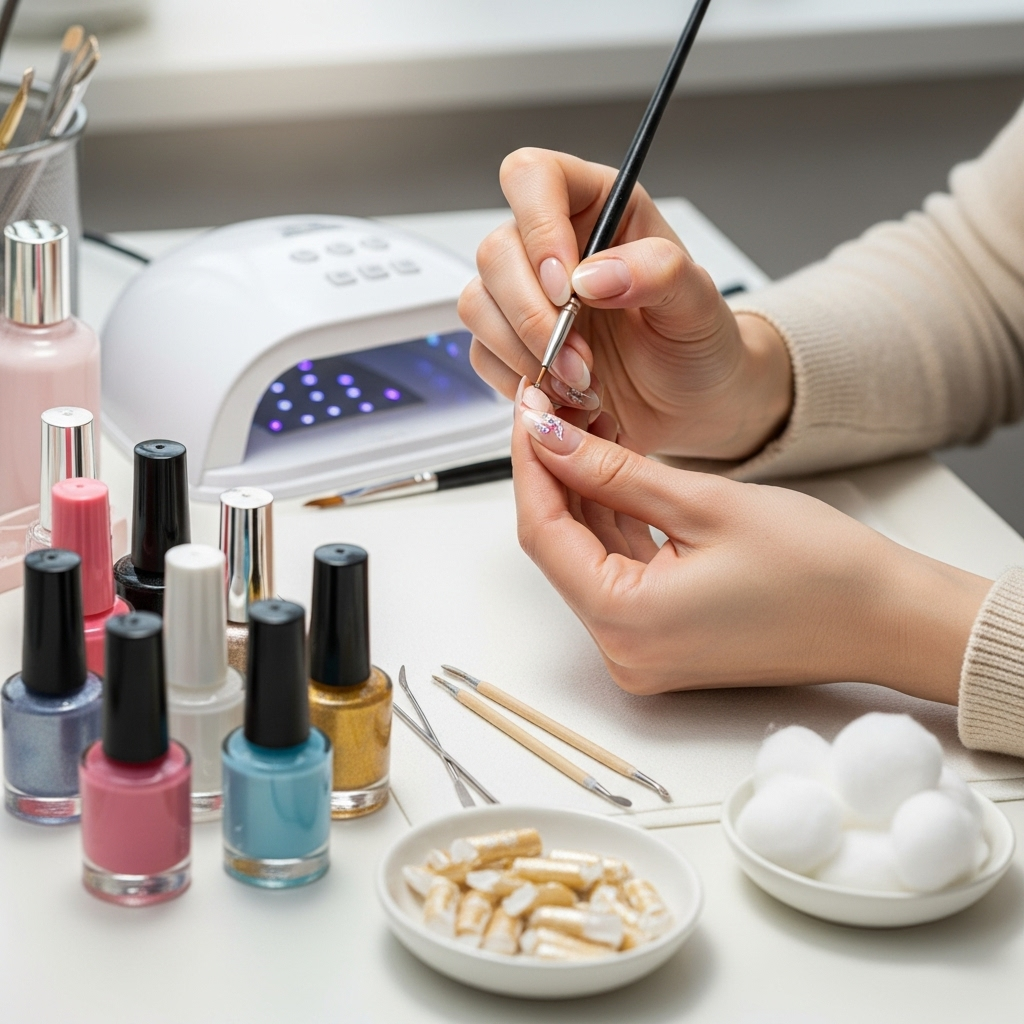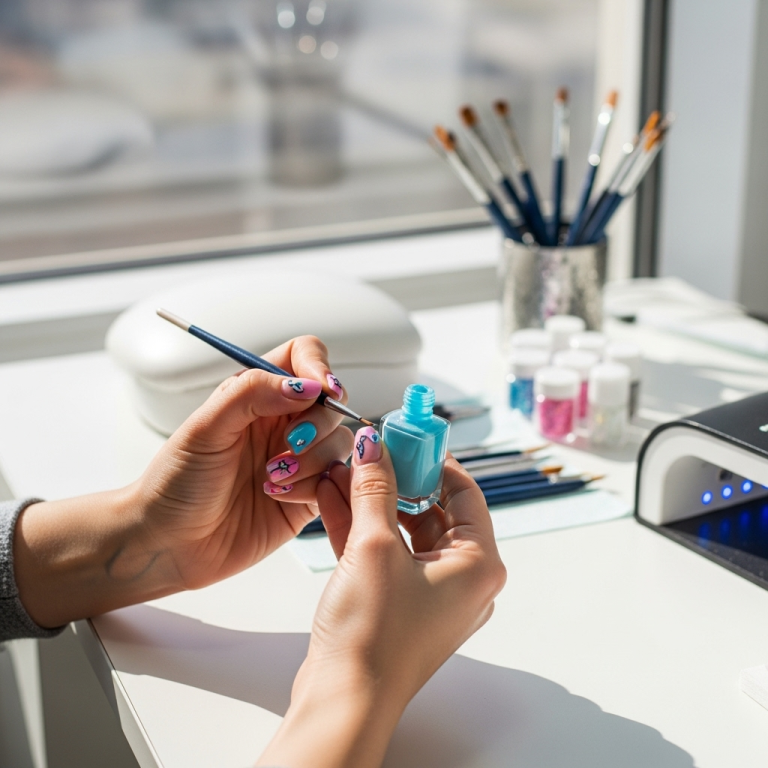Ombre grey to black nails design offers a chic, modern look that’s surprisingly easy to achieve at home. This versatile gradient transitions beautifully from sophisticated light grey to deep, dramatic black, making it perfect for any occasion. Follow our simple guide to master this stunning nail art trend!
Dreaming of sophisticated nails that are both edgy and elegant? The ombre grey to black nail design is your answer! It’s a popular trend for a reason – the smooth transition from a lighter shade of grey to the deepest black is incredibly chic. But sometimes, recreating these salon-worthy looks at home feels totally out of reach, right? Don’t worry one bit! We’re here to break down exactly how to get those gorgeous grey-to-black ombre nails, step-by-step. Get ready to amaze yourself with what your own hands can create!
Mastering the Ombre Grey to Black Nails Design: Your Ultimate Beginner’s Guide
Welcome to the wonderful world of DIY nail art! Today, we’re diving into the super stylish ombre grey to black nail design. This design is fantastic because it’s so versatile. Whether you’re heading to a fancy event or just want to add a little flair to your everyday look, this manicure has got you covered. It’s a bit like magic, watching colors blend seamlessly from soft grey to intense black. And the best part? You don’t need to be a pro nail technician to achieve this look. We’re going to walk through everything you need, and every single step, to make your nails look absolutely stunning.
Why Ombre Grey to Black is a Must-Try
The ombre grey to black nail design isn’t just a fleeting trend; it’s a modern classic that offers so much.
Sophistication with an Edge: Grey is a neutral that speaks volumes, and black adds instant drama. Together, they create a look that’s both refined and a little mysterious. It’s a power manicure that feels grown-up and cool.
Incredible Versatility: This design works with almost any outfit and suits all skin tones. A lighter grey base can brighten things up, while a darker grey can lean into a moodier vibe. You can play with the ratio of grey to black to suit your preference.
Beginner-Friendly: While it looks complex, the technique for ombre nails is surprisingly simple. With a few basic tools and a little practice, you’ll be creating flawless gradients in no time. It’s a fantastic entry point into the world of nail art.
Endless Customization: Want a soft, hazy blend? Or a more defined, sharp transition? You control every aspect. You can even add a touch of shimmer or a matte topcoat for even more variations.
Essential Tools and Materials
Before we start painting, let’s gather our supplies. Having everything ready makes the process smooth and enjoyable. Think of this as prepping your artist’s canvas!
- Base Coat: Protects your natural nails and helps polish adhere better.
- Grey Nail Polish: Choose a shade you love! A medium to light grey often works best as a starter shade for a noticeable gradient.
- Black Nail Polish: The darker, the better for that dramatic finish.
- Top Coat: Seals your design and adds shine for longevity.
- Makeup Sponge (Cosmetic Sponge or Beauty Blender): This is your secret weapon for blending the colors. A coarse-texture sponge works really well for a diffused look.
- Small Dish or Palette: For mixing polish colors or dabbing them onto the sponge. A piece of foil or wax paper works too!
- Cuticle Protector (Optional but Recommended): This can be petroleum jelly, a special cuticle guard liquid, or even glue stick. It prevents polish from sticking to your skin.
- Nail Polish Remover: For cleaning up any mistakes.
- Lint-Free Wipes or Cotton Balls: For applying remover.
- Sanding Files (Optional): To shape your nails if needed.
Step-by-Step: Creating Your Ombre Grey to Black Nails
Ready to dive in? Follow these simple steps, and you’ll have stunning ombre nails in no time. Remember, practice makes perfect, so don’t be discouraged if your first attempt isn’t flawless!
Step 1: Prep Your Nails
Good nail prep is the foundation of any great manicure. Start by gently filing your nails into your desired shape. If you have any old polish on, remove it completely with nail polish remover. Then, apply a thin, even layer of your base coat. Let it dry completely. This step is crucial for protecting your nails and ensuring your polish lasts longer. Think of it as giving your nails a smooth, protective shield!
Step 2: Apply the Base Grey Color
Now, paint your nails with your chosen grey polish. Apply two thin coats for the best opacity. Make sure each coat is completely dry before applying the next. This grey will be the lighter part of your ombre. Ensure you get smooth, even coverage. Patience here means a better-looking final result!
Step 3: Prepare Your Ombre Sponge
This is where the magic happens! Cut a makeup sponge into a few small wedges – about the size that fits comfortably on your fingertip. You want a sponge with a bit of texture, as this helps blend the colors effectively. Some beauty blenders work well, but even a standard kitchen sponge cut to size can do the trick.
If you’re using a cuticle protector (highly recommended!), apply a thin layer around your nails, being careful not to get it on the nail plate itself. This barrier will make cleanup a breeze later.
Step 4: Load Your Sponge with Polish
On your small dish or palette, dab a small amount of your grey polish and a line of your black polish right next to it. You want them to be touching or very close. Don’t over-apply; less is more when starting out.
Now, gently press the edge of your cut sponge into the grey polish, then immediately press the same edge into the black polish. You should see a beautiful blend of the two colors appearing on the sponge. If the colors aren’t mixing enough, try dabbing the sponge onto the palette a couple of times to really integrate them before applying to the nail.
Step 5: Apply the Ombre to Your Nails
This is the key step! Lightly dab the edge of the loaded sponge onto the tip of your nail, where you want the black to start blending into the grey. Use a gentle dabbing motion, working from the tip downwards towards the base of your nail. You might need to re-load your sponge with polish and repeat the dabbing motion a few times to build up the gradient. Apply pressure more gently as you move towards the cuticle to get a softer transition.
Don’t aim for perfection on the first try! The beauty of ombre is its fluid nature. You can go back and add more color to build depth, or dab lighter grey at the base if needed to refine the blend. Many nail artists recommend starting with the black polish at the very tip and dabbing downwards, then using a fresh section of the sponge with just grey polish near the cuticle to ensure a lighter shade there.
Pro Tip: For a more defined look, you can swipe some tape around the sponge to create straighter lines before dabbing. For a softer, more diffused look, use the sponge as is.
Step 6: Build Up the Gradient (If Needed)
Once you have your initial gradient, assess. Do you want the black to be bolder? More grey near the tip? You can repeat the process of loading the sponge and dabbing onto your nail. To create a deeper ombre effect, you can apply another layer of the grey polish to your nail (letting it dry slightly first) and then repeat the sponge dabbing technique. This helps to smooth out any harsh lines and build up the color intensity.
If you find your gradient is too dark at the cuticle, you can use a makeup sponge clean of polish or a small brush dipped in nail polish remover to gently clean up the edges. Some people also find dabbing with a clean part of the sponge after applying the color can help blend further.
Step 7: Clean Up the Edges
Now for the satisfying part: cleaning up! If you used a cuticle protector, gently peel it away. If not, use a small brush (an old, clean makeup brush works well) or a cotton swab dipped in nail polish remover to carefully clean up any polish that got on your skin or cuticles. This step makes a huge difference in how professional your manicure looks. Precision pays off!
Step 8: Apply the Top Coat
Once your ombre design is completely dry, apply a generous layer of top coat. This seals in your hard work, adds a beautiful shine, and protects your polish from chipping. Make sure to cap your free edges by running the brush along the very tip of your nail; this is a classic trick to extend the life of your manicure. Let it dry thoroughly.
Step 9: Admire Your Work!
You did it! Take a moment to admire your stunning ombre grey to black nails. They look salon-perfect, and you achieved them all by yourself. How cool is that?
Tips for the Perfect Grey to Black Ombre
Achieving the perfect ombre can take a little practice. Here are some extra tips to help you along the way:
- Work Quickly: Nail polish dries fast, especially when dabbed onto a sponge. Have everything ready and work efficiently.
- Gentle Dabbing: Don’t scrub the sponge on your nail. Light, repeated dabbing motions are key to a smooth blend.
- Sponge Texture Matters: A smoother sponge might create a blurrier gradient, while a more textured one can give you more control and definition. Experiment to see what you like!
- Layering is Key: Don’t be afraid to build up the color in thin layers. It’s easier to add more than to take away.
- Practice on a False Nail: If you’re nervous, grab a few artificial nails from a drugstore and practice the sponging technique on those first.
- Matte Finish Option: For a different look, swap your shiny top coat for a matte top coat after the color has fully dried.
- Add Glitter: For extra sparkle, you can add a fine glitter polish over the ombre effect or just at the tips before the top coat.
Variations on the Grey to Black Ombre Theme
Once you’ve mastered the basic grey-to-black ombre, why stop there? The beauty of this design is its adaptability. Here are a few ideas to explore:
- Reverse Ombre: Start with black at the cuticle and blend up to grey at the tip. This creates a dramatic, deepening effect.
- Metallic Accents: Add a fine line of silver or gunmetal glitter polish at the transition point for some extra shimmer.
- Geometric Ombre: Instead of a soft blend, use tape to create sharp, geometric lines between grey and black sections.
- Subtle Stripes: Alternate between thin grey and thin black stripes for a more complex, linear design.
- Textured Ombre: Experiment with flocking powder or fine glitters over a wet topcoat to create a velvety or sparkly ombre effect.
- Asymmetrical Ombre: Try blending different shades of grey with black on each nail, or create a diagonal ombre across the nail.
Maintaining Your Ombre Grey to Black Nails
To keep your gorgeous ombre nails looking fresh, a little care goes a long way. Even with the strongest top coat, some maintenance will help:
- Wear Gloves for Chores: When washing dishes, cleaning, or doing anything with harsh chemicals, wear rubber gloves. This protects your polish from damage and your natural nails from excessive moisture.
- Moisturize Regularly: Hydrated hands and cuticles look best. Apply hand lotion and cuticle oil daily, especially before bed. This also helps prevent the edges of your manicure from lifting.
- Avoid Using Nails as Tools: Resist the urge to use your nails to open cans, scrape labels, or pry things open. This is a surefire way to cause chips and breaks.
- Reapply Top Coat: If your manicure starts to lose its shine after a few days, apply another thin layer of your favorite glossy top coat. This can refresh the look and add extra protection.
- Touch Up Chips: If you get a small chip near the cuticle, you might be able to gently file it down and apply a bit of clear polish or the base grey color to blend it in.
Understanding Nail Health and Polish Ingredients
While we love a stunning nail design, it’s important to remember to care for our natural nails too! Using a good base coat is the first line of defense against staining, especially with dark polishes like black. Some traditional nail polishes contain harsh chemicals. The U.S. Food and Drug Administration (FDA) regulates cosmetics, including nail polish, ensuring they are safe for consumer use. However, many brands now offer “3-free,” “5-free,” “7-free,” or even “10-free” polishes, which exclude common chemicals like formaldehyde, toluene, and DBP (dibutyl phthalate) that some people find irritating or prefer to avoid. Choosing these can be a great option for maintaining nail health long-term, especially if you get manicures frequently. Always ensure your nail polishes are stored properly in a cool, dark place to maintain their consistency and prevent them from drying out prematurely.
For those who experience frequent polish chipping or nail breakage, looking into strengthening treatments or considering professional Gel or Dip Powder manicures might be beneficial, though these require different removal processes.
FAQ: Your Ombre Grey to Black Nails Questions Answered
Got questions about the ombre grey to black nail design? We’ve got answers!
Q1: Can I really do ombre grey to black nails at home with a sponge?
Absolutely! Using a makeup sponge is one of the easiest ways for beginners to achieve a beautiful gradient effect at home. It helps blend the colors seamlessly.
Q2: What kind of sponge is best for ombre nails?
A regular makeup sponge or a beauty blender works well. Look for one with a slightly porous or textured surface, as this helps pick up and deposit the polish more effectively for blending.
Q3: My ombre looks streaky. What am I doing wrong?
Streaky results often happen when the polish on the sponge dries too quickly or when you’re not dabbing enough. Try to work quickly, re-load the sponge with polish frequently, and use light, repetitive dabbing motions. Don’t press too hard. Building the gradient in thin layers is also key.
Q4: How do I get a sharp line between the grey and black if I don’t want a soft blend?
For a sharper look, you can use latex tape or regular scotch tape. Apply it to your finger before applying the sponge to create a barrier, or try dabbing the sponge on the polish and then very carefully dabbing onto the nail with intention, almost like stamping. Alternatively, after achieving a soft ombré, you can use a fine brush dipped in nail polish remover to sharpen the line.
Q5: My nail polish stains my cuticles and skin. How do I prevent this?
The best way to prevent staining is to use a cuticle barrier. You can apply petroleum jelly (Vaseline), a peel-off latex liquid barrier, or even a glue stick around your nails before you start applying polish. This creates a protective layer that you can easily peel or wipe away after you’re done, taking any excess polish with it.
Q6: How long does an ombre manicure usually last?
With proper application and care, your ombre grey to black nails can last anywhere from 5 to 7 days, sometimes even longer. Using a good quality base coat and top coat, and reapplying the top coat every couple of days, can extend the life of your manicure.
Q7: Can I do grey to black ombre on short nails?
Yes, absolutely! Ombre looks fantastic on short nails. The gradient effect can actually make short nails appear to be have a bit more length, especially if you focus the transition strategically. Just adjust the size of your sponge dabbing accordingly.
Conclusion: Your Stylish Ombre Grey to Black Nails Await!
There you have it! Creating a stunning ombre grey to black nail design at home is totally achievable, even if you’re new to nail art. We’ve covered everything from the essential tools to the nitty-gritty steps, plus some extra tips and tricks to perfect your gradient. Remember, nail art is all about self-expression and having fun. Don’t be afraid to experiment with different shades of grey, play with the transition, and make it your own. With a little patience and practice, you’ll be rocking these sophisticated, edgy nails in no time. So grab your polishes, your sponge, and get ready to transform your nails into a work of art. Happy painting!




